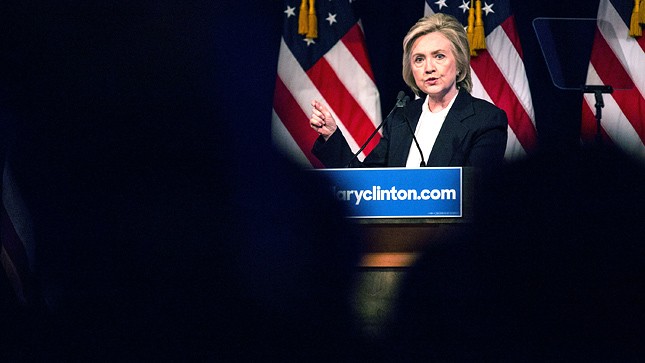
What makes an email classified?
It’s the question at the center of a heated back-and-forth over a government report that determined Hillary Clinton’s private email server contained numerous emails now classified “top secret.”
Clinton’s detractors have portrayed the revelation as further evidence of a dishonest secretary of State who put national security at risk with her email arrangement. It’s just more proof, they say, that the Democrat’s White House frontrunner is unqualified to occupy the Oval Office.
Clinton’s campaign and the State Department have countered that the findings are merely the result of agency disagreements over what constitutes “classified” and the various ways information can be deemed secret years after the fact. They maintain Clinton only used her private server for unclassified emails.
“Sometimes it’s black and white, but oftentimes it’s not,” said Mark Toner, State Department deputy spokesperson, during a Wednesday briefing. “There’s lots of considerations to take into account when looking at these.”
So what are those considerations? How, exactly, does an email become classified?
The seemingly basic question has a surprisingly complex answer.
“There is so much classified information being generated and circulated, there are so many people with the authority to classify, inevitably there is friction and confusion in the system,” said Steven Aftergood, an expert on classification policy and director of the Federation of American Scientists Project on Government Secrecy.
And in an era in which more and more government business is done via email, the determination is becoming one that consumes federal officials.
Several former intelligence and civilian government officials described juggling up to three different computer terminals that housed separate email accounts — one for unclassified email, one for “secret” classified email and another for “top secret” classified email.
“It’s something I had to think about all of the time,” said John Cohen, former acting undersecretary for intelligence and analysis at the Department of Homeland Security (DHS).
On one level, the process is very simple. Initially, the president determines what should be classified.
But it quickly spirals out from there.
Presidents have always delegated much of their classification power. In 2009, President Obama issued an executive order that deputized individuals within various agencies to set classification guidelines for their workers.
These officials are required, every five years, to review their agency’s classification policy. The last such government-wide review was in 2012, although Aftergood noted, “the guidance is constantly in flux.”
Broadly speaking, these guidelines are based on whether the information might expose the government’s “sources or methods,” according to former officials. For instance, does the language tip off a criminal group that investigators have tapped into their communications? Could a particular sentence reveal where a U.S. diplomat is getting information on a foreign adversary?
These distinctions are explained in regular training sessions for employees, usually held annually. Because on a day-to-day basis, it’s ultimately these workers that determine whether or not an email they’re about to send contains classified information.
“It’s incredibly challenging,” said Cohen, who also oversaw DHS counterterrorism programs. “You are, in the course of any given day, provided huge amounts of information, some of it highly classified, some of it classified at lower levels, some of it unclassified."
However, the classified determination doesn’t end once an email has been sent.
Information in a message can be declared classified years after it was initially sent. And the State Department and intelligence community can also look at the same text and come to opposite conclusions over whether it contains secret information.
And that’s where the discrepancies are arising between the Intelligence Community’s inspector general (IG), Clinton’s campaign and the State Department.
The IG’s note to Congress on Tuesday addressed the distinction.
The watchdog said it found a number of Clinton’s emails that currently contained “classified intelligence community information.” But the State Department has said it did not consider that language classified at the time those emails were sent.
Both sides can be correct, said several former officials.
Not only is each side entitled to different standards of classification, but information can become classified almost retroactively, as situations and guidelines change over the years.
An inspector general could decide “it is a completely different scenario,” and that certain details must now be protected, said Michael Brown, a former DHS director of cybersecurity coordination and current vice president at security firm RSA.
And culturally, intelligence agencies tend to lean towards classification more than an agency like State would, several former employees on both sides agreed.
The Clinton campaign stood by this explanation in its defense.
“It's common for information previously considered unclassified to be upgraded to classified before being publicly released,” Campaign Communications Director Jennifer Palmieri said in an email sent Wednesday to supporters. “Some emails that weren't secret at the time she sent or received them might be secret now.”
“And sometimes government agencies disagree about what should be classified,” Palmieri added.
But a major discrepancy arises when it comes to two emails the IG said contained “classified State Department information when originated.” That means when someone hit send years ago on an unclassified email to Clinton’s account, those messages included details considered secret at the time.
“There is an inconsistency and we are missing some facts,” Aftergood said.
At his Wednesday briefing, Toner said State was “now assessing that ourselves, internally.”
Experts and officials could only speculate as to what might have occurred. Most likely, several people said, someone accidentally put State Department classified information into a message before sending it to Clinton.
With email's rising ubiquity, such a mistake has become a common way secret data is leaked.
“I’d say over the last 5, 10 years, when you have that leakage that occurs, it was an inadvertent writing of information that was classified,” Brown said.
But questions remain, several experts cautioned.
One of the facts we’re missing is who originally generated the information in question,” Aftergood said. “The way this story is coming out in dribs and drabs, we are left without a lot of context.”


